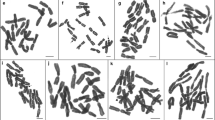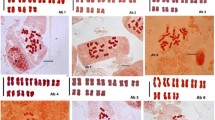Abstract
Cytological analyses were performed in nineteen accessions belonging to seven Achillea species. The results indicate that two species, A. filipendulina and A. tenuifolia, are diploid (2n = 2x = 18) and three species, A. bieberstinii, A. pachycephala, and A. aucheri are tetraploid (2n = 4x = 36). For two latter species, the chromosome numbers are new. Two ploidy levels of 2n = 6x = 54 and 2n = 8x = 72 in A. millefolium and two ploidy levels of 2n = 2x = 18 and 2n = 4x = 36 in A. santolina species were found. Cluster analysis based on chromosomal characteristics and karyotype asymmetry indices clustered the studied genotypes into three major groups. The first group included the diploid species (A. filipendulina, A. santolina and A. tenufolia), while the second group comprised tetraploid species (A. santolina, A. aucheri and A. pachycephala). A. millefolium (hexaploid, octaploid) and A. bieberstinii (tetraploid) were classified in the third group. Total form percentage (TF%) in groups 1, 2 and 3 were 42.03, 42.15 and 41.08, respectively. Group 1 possessed the highest average of symmetry index (S% = 70.8). Stebbins classification method grouped all accessions in class A. Moreover, group 1 (diploid level species), had the most symmetric karyotype from point of view of centromere and chromosome length. Therefore, it can be concluded that the genotypes belonging to group 1 are the earliest evolutionary form.
Similar content being viewed by others
References
Artimage A.M. 1992. Field studies of Achillea as a cut flower: longevity, spacing, and cultivar response. J. Amer. Soc. Hortic. Sci. 117: 65–67.
Baltisberger M. 2006. Cytological investigations on Bulgarian phanerogams. Willdenowia 36: 205–216.
Benedek B., Kopp B. & Melizg M.F. 2007. Achillea millefolium L.S.l.dis the anti-inflammatory activity mediated by protease inhibition? J. Ethnopharmacol. 113: 312–317.
Bremer K. & Humphries C.J. 1993. Generic monograph of the Asteraceae-Anthemideae. Bull. Brit. Mus. (Natl. History) Bot. 23: 71–177.
Bremer K. 1994. Asteraceae: Cladistic and Classification. Portland, OR, Timber Press.
Costa J.Y. & Forni-Martins E.R. 2003. Karyology of some Brazilian species of Alismataceae. Bot. J. Linn. Soc. 143: 159–164.
Danihelka J. & Rotreklová O. 2001. Chromosome numbers within the Achillea millefolium and the A. distans groups in the Czech Republic and Slovakia. Folia Geobot. 36: 163–191.
Dabrovska J. 1977 Observations of the fruit size of nine taxons from the genus Achillea L. representing natural di-, tetra-, hexa- and octaploids. Herba Pol. 28: 55–66.
Dabrovska J. 1989. The chromosome numbers of several taxa of the genus Achillea L. Acta Bot. Pol. 58: 163–177.
Ehrendorfer F. 1953. Systmatische und zytogenetische Untersuchungen an europäischen Rassen des Achillea millefolium-Komplexes. (Vorläufige Mitteilung). Öster. Bot. Zeitschrift 100: 583–592.
Ehrendorfer F. 1959. Differentiation-hybridization cycles and polyploidy in Achillea. Cold Spring Harb. Symp. Quant. Biol.24: 141–152.
Ehrendorfer F. & Guo Y-P. 2006. Multidisciplinary studies on Achillea sensu lato (Compositae-Anthemideae): new data on systematic and phylogeoography. Willdenowia 36: 69–87.
Ehrendorfer F. 1973. New chromosome numbers and remarks on the Achillea millefolium polyploid complex in North America. Plant Syst. Evol. 122: 133–143.
Evenor D. & Reuveni M. 2004. Micropropagation of Achillea filipendulina cv. ‘Parker’. Plant Cell. Tiss. Org. Cult. 79: 91–93.
Frasi M., Alhoseini Goreishi J. & Jafari E. 2000. Cytological studies of some Iranian Achillea species. J. Agric. Knowl. 11: 18–37 (in Persian)
Ghaffari S. M. 1989. Chromosome studies in Iranian compositae. Iran. J. Bot. 4: 189–196.
Guo Y-P., Saukel J., Mittermayr R. & Ehrendorfer F. 2005. AFLP analyses demonstrate genetic divergence, hybridization, and multiple polyploidization in the evolution of Achillea (Asteraceae-Anthemideae). New Phytol. 166: 273–290.
Guo Y-P., Saukel J. & Ehrendorfer F. 2008. AFLP trees versus scatterplots: evolution and phylogeography of the polyploid complex Achillea millefolium agg. (Asteraceae).Taxon 17: 153–169
Gurevitch J. 1988. Variation in leaf dissection and leaf energy budgets among populations of Achillea from an altitudinal gradient. Amer. J. Bot. 9: 1298–1306.
Khaniki G.B. 1995. Chromosome numbers and morphometry in Achillea (Anthemideae, compositae). Nucleus 38: 104–111.
Kiran Y., Arabaci T., Sahin A. & Turkoglu I. 2008. Karyological notes on another eight species of Achillea (Asteraceae) from Turkey. Biologia 63: 343–34.
Magiatis P., Skaltsounis AL., Chinou I. & Haroutounian SA. 2002. Chemical composition and in vitro antimicrobial activity of the oils of three Greek Achillea species. Z. Naturforsch. 57: 287–290.
Mercado-Ruaro P. & Delgado-Salinas A. 1998. Karyotypic studies on species of Phaseolus (Fabaceae: Phaseolinae). Amer. J. Bot. 85: 1–9.
Pireh W. & Tyrl RJ. 1980. Cytogeography of Achillea millefolium in Oklahoma and adjacent States. Rhodora 80: 361–367.
Post G.E. 1933. Flora of Syria, Palestina and Sinai. American Press, Beirut 2: 44–47.
Rahimmalek M., Sayed Tabatabaei B.E., Arzani A. & Etemadi N. 2009. Assessment of genetic diversity among and within Achillea species using amplified fragment length polymorphism (AFLP). Bioch. Syst. Ecol. 37: 354–361.
Rechinger K.H. 1963. Flora Iranica. No. 158. Akademische Druke-U. Verlagsanstalt, Wien, Austria, pp. 49–71.
Reeves A. 2001. Micromeasure: a new computer program for the collection and analysis of cytogenetic data. Genome 44: 439–443.
Ronald J & Tyrl R.J. 1975. Origin and distribution of polyploid Achillea (composite) in western north America. Brittonia 27: 187–196
Ruas P.M., Ruas C.F., Maffei E.M.D. & Marin-Morales M.A. 2000. Chromosome studies in the genus Mikania (Asteraceae). Genet. Mol. Biol. 23: 979–98.
Sahin A., Kiran Y., Arabaci T. & Turkoglu I. 2006. Karyological notes on eight species of Achillea L. (Asteraceae, Santolinoideae) from Turkey. Bot. J. Linn. Soc. 151: 573–580.
Saukel J., Ancev M., Guo Y-P., Vitkova A., Nedelcheva A., Goranova V., Konakchiev A., Lambrou M., Nejati S., Rauchensteiner F. & Ehrendorfer F. 2004. Comments on the biosystematics of Achillea (Asteraceae-Anthemidae) in Bulgaria. Phytol. Balcanica 9: 361–400.
Sheidai M., Azanei N. & Attar F. 2009. New chromosome number and unreduced pollen formation in Achillea species (Asteraceae). Acta Biol. Szeged 53: 39–43.
Stebbins G. L. 1971. Chromosomal evolution in higher plants. E. Arnold Ltd., London, UK.
Zheng-Yi W. & Raven P.H. 1994. Flora of China. Vol. 17. Science Press, Missouri Botanical Garden, USA.
Author information
Authors and Affiliations
Corresponding author
Rights and permissions
About this article
Cite this article
Ebrahim, F., Pakniyat, H., Arzani, A. et al. Karyotype analysis and new chromosome number reports in Achillea species. Biologia 67, 284–288 (2012). https://doi.org/10.2478/s11756-012-0011-3
Received:
Accepted:
Published:
Issue Date:
DOI: https://doi.org/10.2478/s11756-012-0011-3




